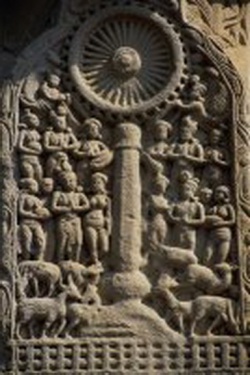Wheel
- See also :
- See also :
The wheel (cakka) is a flat circular object that turns as it moves. The ancient Indians used the wheel as a symbol for political sovereignty and domain. The first Buddhists used it as a symbol for sovereignty too, only for spiritual rather than for political sovereignty. The Buddha’s first discourse is called ‘Setting in Motion the Wheel of the Dhamma.’ (S.V,420). The rim of the wheel (mukhavaṭṭi) represent movement or progress and the spokes (ara) and hub (nābhi) represent the coming together of multiple things into a unity. Generosity, kindly speech, doing good for others and treating them with impartiality are to the world, the Buddha said, what the linchpin (āṇi) is to the wheel (A.II,32), i.e. they keep it turning smoothly. A wheel flanked on either side by a deer has long been used to symbolize the Buddha’s teaching of this discourse at the Deer Park at Sārnāth.
The Wheel is also called Dharmachakra. Buddha is said to have "turned the wheel of the dharma" and it therefore became the "wheel of law." It represents the overall teachings of the Buddha and is one of the most important Buddhist symbols. In Tibet, it is called the "the wheel of transformation."
A wheel is an object intended for mobilization and this is symbolic of the motion of the soul as it progress along the spiritual path. It embodies change and also represents the never ending cycle of samsara, or rebirth. The cycle of samsara can only be broken by following the path of the Buddha and reaching enlightenment. The hub stands for training in moral discipline. There are eight spokes on the wheel which are reflections of the Noble Eightfold Path. The spokes represent the correct application of wisdom, which ends ignorance and suffering. The rim represents concentration, which is essential to the successful meditative practice.
In the present context, the wheel is a ubiquitous symbol in Buddhist art and culture. The wheel is often depicted on the body of Buddha, usually on his palms and the soles of his feet. The wheel is also commonly found in the center of mandals, representing the wholeness and totality of the universe.
Today the wheel as a symbol for Buddhism is often depicted with eight spokes representing the Noble Eightfold Path although this is a relatively recent innovation. In the scriptures the Dhamma wheel, called either the Supreme Wheel (brahmacakka) or Highest Wheel (anuttaraṃ dhammacakkaṃ, A.III,9; 148), was perceived as being ‘a thousand-spoked’ (sahassāraṃ, D.III,60). Before the advent of statues, the Buddha was often represented by a wheel. What the cross is to Christians, the ying yang symbol to Taoists and the Om sign to Hindus, the wheel is to Buddhists.
The Buddhist Wheel Symbol, T. Karunaratne, 1969.
